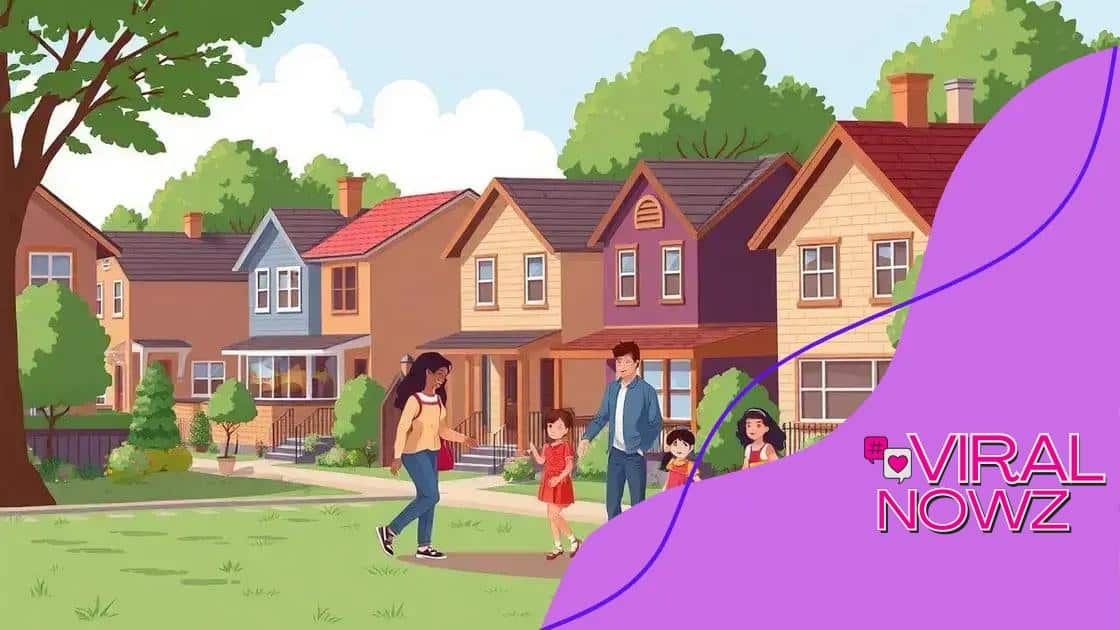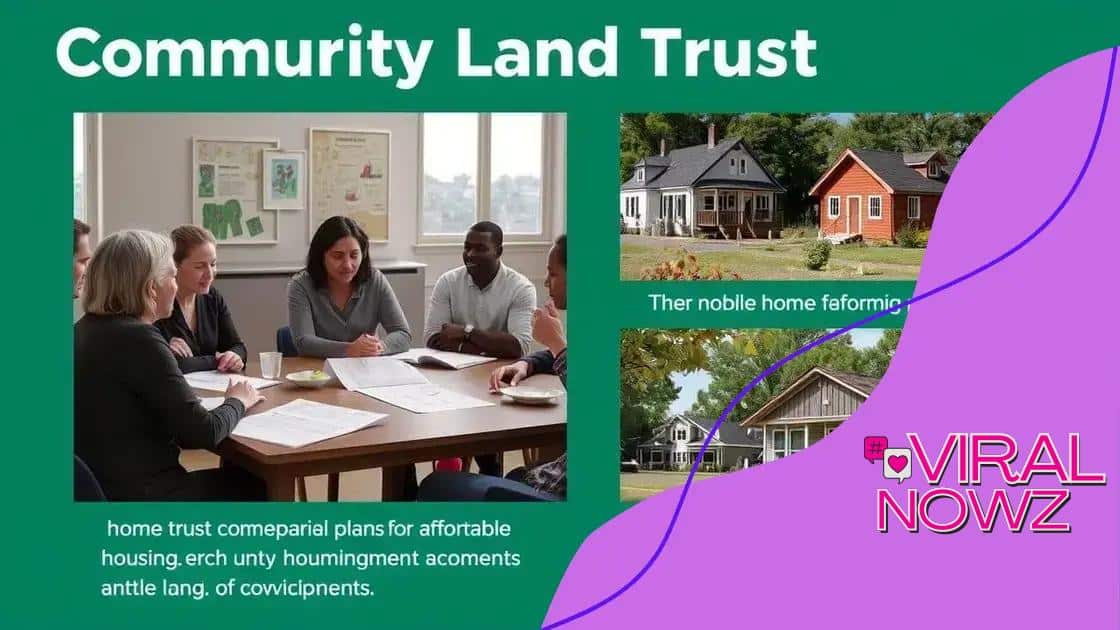Expanding access to affordable housing under new federal policies

Expanding access to affordable housing under new federal policies involves innovative solutions like community land trusts and modular housing, effectively addressing rising costs and regulatory challenges to ensure all families can secure stable and affordable living conditions.
Expanding access to affordable housing under new federal policies presents a pivotal opportunity for many Americans. Have you ever thought about how these changes might affect your neighborhood or community? Let’s dive into what these policies entail and who they benefit.
Understanding the new federal housing policies
Understanding the new federal housing policies is essential for grasping how these changes will reshape the landscape of affordable housing. These policies aim to enhance accessibility for many struggling families.
Key Components of the New Policies
These federal policies include various initiatives designed to assist in building, improving, and maintaining affordable housing. By introducing new funding opportunities and resources, the government is taking steps towards a more inclusive housing market. Here are some key components:
- Increased funding for housing assistance programs.
- Tax incentives for developers to build affordable units.
- Streamlined zoning regulations to facilitate faster construction.
The significance of these modifications can’t be overstated. They not only aim to balance the housing market but also to cater to the needs of low-income families who have been marginalized for far too long.
Impact on Local Communities
The impact on local communities can be profound. As these policies are implemented, cities will see growth in the availability of affordable options. This influx can lead to more diverse neighborhoods and enhanced community welfare. Additionally, it opens the door for:
- Reducing homelessness through expanded housing choices.
- Supporting local economies by creating jobs in construction and maintenance.
- Promoting social equity by ensuring diverse income levels can thrive in the same area.
As these federal guidelines are rolled out, communities will have to adapt and respond positively. Understanding these policies will help residents advocate for their implementation effectively. By staying informed, families can benefit from improved access to affordable housing and work towards a brighter future.
The impact on low-income families
The impact on low-income families from the new housing policies is significant and far-reaching. These policies are designed to provide much-needed support and resources that can improve their living conditions.
Improved Access to Housing
One of the main effects of these policies is the enhanced access to affordable housing options. Families who previously struggled to find suitable homes will now have more opportunities. With increased funding and support for housing assistance programs, many households can secure stable living conditions.
- Lower rental costs for families.
- More housing options in various neighborhoods.
- Reduced waiting times for assistance programs.
This increase in availability can lead to more families being able to live in areas that are safer and closer to schools or jobs. Besides, it encourages community building among residents.
Economic Stability and Growth
The new housing initiatives also promote economic stability for low-income families. When families find a stable home, they can focus on improving their lives. They can invest in education and skill development, leading to better job opportunities.
Additionally, access to affordable housing can lead to a ripple effect. As families spend less on housing, they have more resources to invest in:
- Education and training.
- Healthcare and nutrition.
- Personal savings and investments.
This shift not only helps individual families but also strengthens the overall economy, creating a cycle of growth and stability. The changes in housing policy reflect a commitment to uplifting those who need it most.
Innovative solutions for affordable housing

Innovative solutions for affordable housing are becoming increasingly important as cities seek to address housing shortages. These creative approaches aim to provide sustainable living options for those in need.
Community Land Trusts
One innovative solution is the establishment of community land trusts (CLTs). These nonprofit organizations acquire land and maintain it for community benefit. By removing land costs from the housing equation, CLTs can ensure housing remains affordable.
- CLTs allow for more equitable access to land.
- They help preserve affordability over time.
- They strengthen community engagement and ownership.
This model provides stability and encourages residents to invest in their neighborhoods, fostering a sense of belonging and community pride.
Modular and Prefabricated Housing
Another solution gaining traction is the use of modular and prefabricated housing. These homes are built off-site and then assembled on location, resulting in significant cost savings and reduced construction time. This method can provide:
- Faster delivery of homes to those in need.
- Lower construction costs, making housing more accessible.
- Reduced waste and environmental impact.
As demand for quick and affordable housing solutions grows, modular housing stands out as an effective option.
Adaptive Reuse of Buildings
Adaptive reuse is the process of repurposing old buildings for new uses. This practice not only preserves historical architecture but also contributes to affordable housing. By transforming unused spaces into livable units, cities can:
- Maximize existing resources and infrastructure.
- Reduce urban sprawl and environmental impact.
- Create unique housing options that integrate into neighborhoods.
These creative approaches highlight how innovative thinking can tackle the pressing issue of affordable housing, ensuring more families have a place to call home.
How communities are implementing these changes
How communities are implementing these changes reflects a collaborative effort to improve affordable housing availability. Various towns and cities are adopting innovative strategies to integrate new federal policies effectively.
Community Workshops and Meetings
Many communities are hosting workshops and public meetings to educate residents about the new policies. These gatherings encourage participation and feedback, allowing locals to voice their needs. Such initiatives create a platform for:
- Understanding the federal guidelines.
- Identifying specific community needs.
- Building local support for new housing projects.
By promoting dialogue, communities can foster a sense of ownership over the changes that affect them directly.
Partnerships with Nonprofits
Another approach involves partnerships between local governments and nonprofit organizations. These collaborations can enhance resources for affordable housing projects. Nonprofits often bring valuable experience and connections to the table, leading to:
- Streamlined processes for housing development.
- Increased funding opportunities.
- Access to community-oriented programs.
These partnerships help to ensure projects align with community needs while also leveraging different skill sets and perspectives.
Innovative Funding Solutions
Communities are also exploring innovative funding solutions to finance affordable housing initiatives. For instance, some towns are utilizing tax increment financing (TIF) to support development in specific areas. This funding method allows local governments to:
- Capture future tax revenue generated by new developments.
- Reinvest in community improvements.
- Support various housing projects sustainably.
As communities continue to implement these changes, the focus remains on creating lasting solutions that will benefit future generations. By taking proactive steps and collaborating with different stakeholders, towns are laying the groundwork for improved living conditions.
Future challenges in affordable housing markets
The future challenges in affordable housing markets are complex and multifaceted. As communities strive to implement new policies, they will face various obstacles that could impact the success of affordable housing initiatives.
Rising Construction Costs
One significant challenge is the rising costs of construction materials and labor. As demand increases, so do prices, making it harder to create affordable housing options. Higher costs can lead to:
- Increased prices for housing units.
- Delays in project completion.
- Reduced overall availability of affordable homes.
These factors make it essential for communities to find innovative ways to manage and mitigate expenses.
Regulatory Hurdles
Regulatory issues also pose significant challenges. Zoning laws, permitting processes, and land use regulations can slow down housing development. Communities may struggle with:
- Outdated zoning practices that hinder new construction.
- Bureaucratic delays in obtaining necessary approvals.
- Resistance from local residents against new developments.
Addressing these regulatory hurdles will require collaboration between government officials, community members, and developers.
Market Demand vs. Supply
The balance between housing supply and market demand is another crucial area of concern. In many cities, demand for affordable housing far outstrips supply, leading to increasing competition for available units. This situation creates challenges such as:
- Price inflation in rental and purchase markets.
- Greater homelessness rates among low-income families.
- Long wait times for available housing.
Communities need to develop strategies to boost supply while effectively meeting the growing demand.
As these challenges unfold, it becomes vital for stakeholders to work together to create sustainable solutions that will support affordable housing efforts in the long term. Proactive planning and community engagement will be key to navigating the future landscape of affordable housing.
FAQ – Frequently Asked Questions about Affordable Housing
What are some innovative solutions for affordable housing?
Innovative solutions include community land trusts, modular housing, and adaptive reuse of buildings, which help increase housing availability.
How do rising construction costs impact affordable housing?
Rising construction costs can lead to increased housing prices and delays in project completion, making it harder for families to find affordable homes.
What role do community workshops play in affordable housing?
Community workshops engage residents in discussions, allowing them to voice their needs while fostering local support for housing projects.
What challenges do communities face in implementing housing policies?
Challenges include regulatory hurdles, market demand exceeding supply, and managing rising costs for materials and labor.





